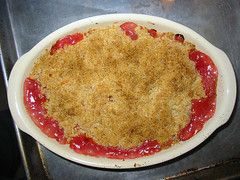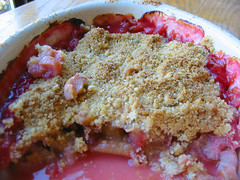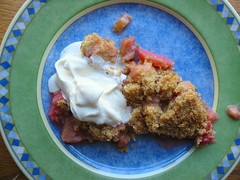I’ve made no secret of my love of the farmers market and of local food in general. So when I went to see Michael Pollan read on Friday night and he said pretty much the same thing, why did it make me uneasy? It’s probably because of the chocolate factory.
Pollan is the author of The Botany of Desire and the new book The Omnivore’s Dilemma. _The Botany of Desire_ is a great book about how plants have used humans–not consciously, of course–to propagate the plant genes by stumbling upon features that humans find highly desirable. (One of the plants Pollan explores is _Cannabis sativa_, and he does hands-on research in Amsterdam.)
His new book, which I haven’t read yet, explores three aspects of the food chain: the industrial, organic, and hunter-gatherer. An excerpt, about Pollan going boar hunting, appeared recently in the New York Times Magazine (it’s now in the TimesSelect ghetto).
As I understood Pollan’s gist, he would have us abandon industrial food production in favor of small organic farms and cooking with whole foods. I’m sure that’s an oversimplification, but that’s how it sounded.
The problems with industrial food have been so often recounted that there’s no need for me to repeat them here, but just to take a stab at it: soil erosion, eutrophication of water, factory farm animals living in misery and squalor, dangerous reliance on monocultures, antibiotic resistance, vegetables devoid of vitamins and minerals, and bland food.
All of these problems are absolutely real. I have a degree in ecology, and I consider myself an environmentalist. Where I part ways with Pollan–well, let’s get back to the chocolate factory.
In the current (May) issue of Seattle Magazine, I have an article about [Theo Chocolate](http://www.theochocolate.com/), a new chocolate factory in Fremont. A new chocolate factory is not a common thing. There are less than two dozen chocolate factories in the US, and most of them are operated by huge conglomerates like Hershey and Nestle. Theo is aiming to be the greenest chocolate producer around–all of their beans are organic and fair trade. Also, they painted their machinery green. It’s pretty awesome. I got free samples. (Sadly, the article isn’t online, but I’ll put it up as soon as my contract allows.)
If you go to an artisan bakery, you’ll see people forming loaves by hand, maintaining buckets of sourdough starter, and basically doing things exactly how they were done five hundred years ago, but with larger ovens and electric mixers. Chocolate isn’t like that. Making chocolate bars is a truly industrial process. (It’s possible to do it by hand, but it’s absurdly labor-intensive. Scharffen-Berger has a handmade three-ounce bar that sells for $8.) Sure, Theo is my local chocolate factory, so in that sense it’s local food, but the beans come from half a dozen tropical countries around the globe. Even if they were making the chocolate by hand, they’d be relying on the shipping industry.
> Likewise, I wish Pollan would stick his neck out and be more prescriptive about how we might realistically address our national eating disorder. We can’t all go off the grid like Salatin, nor can we just wish away 200 years of industrialization. So what to do? Is the ever-growing organic-food industry already on the right path? Or is more radical action needed?
That’s what the New York Times Book Review said, and it’s my critique of Pollan’s talk in a nutshell. On the one hand, you have a Valrhona Le Noir Amer 71% bar. On the other, high-fructose corn syrup. Both are products of the industrial food chain. If I have to give up the Valrhona to get rid of the HFCS, well, forget it.
My hunch is that Pollan’s critique begins with aesthetics. There’s nothing wrong with aesthetics–I believe beautiful and delicious things have value for no other reason than their beautiful deliciousness. But everyone wants to bolster their aesthetic argument with something meatier. A pasture full of contented cows is beautiful. Organic heirloom tomatoes are delicious. A McDonald’s drive-thru is ugly, and supermarket tomatoes are nasty. It’s very easy to jump from there to saying that McDonald’s and supermarket tomatoes are not only unwholesome but (the most damning word of the moment) *unsustainable*.
Maybe they are. But I don’t think you can win this way. I don’t shop at the farmers market because the farmers are nice. I shop at the farmers market because *that’s where the best food is*. And I usually stop at the supermarket on the same trip.
That’s the direction I think we’re headed in: not a wholesale abandonment of industrial food, but more and more a mixture of industrial and artisanal, local and global food. I think it’s at least theoretically possible to put those things in healthy balance.
Of course, that could be the Valrhona bar talking.



